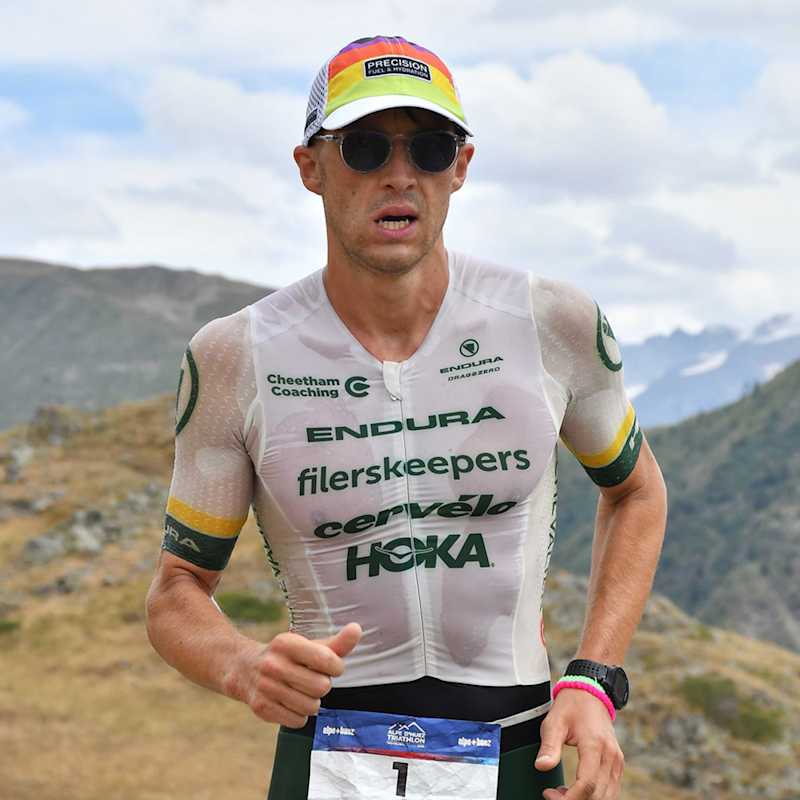
Leon Chevalier
IRONMAN® World Championships
Leon's headline numbers
Leon's strategy
Fueling
Carbohydrate is the main fuel you burn when racing. Failing to fuel properly is a leading cause of underperformance in longer races.
Compared to his previous IRONMAN® races, Leon made a conscious decision to consume more carb (+13g/h) during the marathon than on the bike. That’s not to say his carb intake on the bike was low, as he still consumed ~128g/h on his way to the second fastest Kona bike split in history (🤯). Leon has consumed in the region of ~125g/h carbs in prior races, and this slightly lower intake (relative to the run) on the bike helped him reduce the risk of GI distress from consuming too much carb early on, which can sometimes happen in high temperatures. Leon then pulled hard on his fueling lever, consuming 13 Gels during the run and averaging almost ~150g of carb per hour! Based on the scientific literature, we normally advise reducing carb consumption when racing in the heat as athletes sweat more which reduces total blood volume. Blood is also directed away from the gut towards the skin when exercising in the heat to help keep us cool, both of which work against the absorption capacity of the gut. However, Leon has routinely demonstrated the ability to tolerate high carb intakes with very little incidence of GI distress in the past and this was the case once more in this race.
Hydration
Taking on board an appropriate amount of fluid and sodium is essential to maintaining blood volume and supporting the cardiovascular effort needed to perform on race day.
Whilst the absolute amount of sodium and fluid consumed per hour is important, it’s critical to consider these in relation to each other. This is known as 'relative sodium concentration' and it’s expressed in milligrams per litre (mg/L). How much sodium you’re taking in per litre of fluid is more important than the absolute amount taken in per hour.
Sweat sodium concentration (mg/L) is largely genetically determined and remains relatively stable. Knowing how salty your sweat is enables you to replace a good proportion of your sweat losses, which can range from 200-2,000mg/L.
Given Leon’s losses are High (1,392mg/L), nailing his hydration strategy becomes especially crucial when it’s hot and/or humid.
Learn moreBike Hydration: Leon’s bike bottles had his usual highly concentrated carb and electrolyte mix in them, which he’s used at the last three IRONMAN® World Championships and numerous other races in between. When jumping on the bike, however, Leon caught his leg on the 1L bottle behind his saddle which snapped the bottle cage off, forcing him to discard 1,500mg of sodium and 150g of carb, as athletes are no longer allowed to hold bottles down the front of their tri suits. Thankfully, he’d prepared for this scenario and had a spare bottle of everything he lost waiting for him at the halfway personal needs aid station. By picking up plenty of water from the on-course aid stations, Leon not only consumed a large amount of fluid, but also poured plenty over his entire body to prevent his skin and core temperatures from rising too much.
Run Hydration: Leon drank the highest amount of fluid we’ve seen him consume during any IRONMAN® run, with a whopping ~5.3 litres (😳) going down the hatch, along with plenty going over his head. He unfortunately missed his tri suit pocket on the way out of T2 as he tried to carry some Electrolyte Capsules, dropping them on the floor. This, combined with his deliberate avoidance of the on-course hydration as it was something he’d never drank before, meant he didn’t have any sodium during the run. Given that he’s a salty sweater, this wasn’t an ideal strategy for Leon to follow as it would have increased his risk of hyponatremia. However, despite this, Leon still managed to put together a very solid run. He was potentially helped by three factors: 1) he’d consumed over 900mg of sodium per hour on the bike; 2) he was well acclimated to the hot and humid conditions, and 3) as a fast running professional athlete, he was 'only' on the run for 2 hours and 49 minutes in total.
How Leon hit his numbers
Here's everything that Leon ate and drank on the day...
Leon's weapons of choice
Final thoughts
Leon's full stats
Data Confidence?
There is an adequate level of accuracy in the data collected and the numbers reported. The athlete manages to recall what they ate and drank including most specifics (brands flavours quantities plausible estimations of volumes). However there are estimations made within the data which affect the overall confidence level in the data reported.